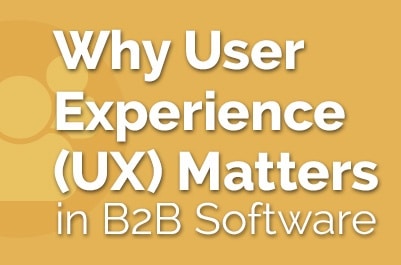10 August 2016
Why User Experience (UX) Matters in B2B Software
 Everyone loves to use a well-designed app.
Everyone loves to use a well-designed app.
Consumer apps get all the love and adoration. And why not? They have to succeed on their own and the competition is fierce.
So a great design and a stellar experience is key to a consumer app’s success.
But why isn’t B2B software given any love?
You probably have that same picture in your head of an endless stream of bland, gray menus with boring icons. The reason why is because too many companies don’t care about this.
What does this mean? An easy way for your software to stand out from the crowd.
But that’s not the only reason. Well-designed B2B software improves efficiency, makes for happier customers, and increases sales. We’ll show you why in this blog post.
1. Improve Efficiency
Here’s the thing: user experience is more than colors and fonts.
User experience is about understanding the deeper need a user has, and addressing that need with options and tools in the best way.
Or to put it another way – great design does some of the thinking for you.
You can see it in consumer apps that make it really easy for you to share photos, add contacts, get notifications – apps like WhatsApp, Pokemon Go, Prisma – these consumer apps all have a problem or opportunity they solve for the user and they’ve spent considerable brainpower finding the ideal solution for their customer to do what they want to do within the app – the result of this is something the customer probably doesn’t even notice: efficiency.
Because the apps are so well designed and cater so perfectly to the users’ needs, they’re incredibly efficient at their tasks. And they should be, any inefficiency is a friction point that could cause the user to abandon the app for a competitor.
This kind of thinking is unfortunately lost in B2B software. They tend to be developed to meet a feature list or check off a series of boxes – the user becomes secondary.
Without thinking of the user first and designing the best solution for them, how can you be sure that it’s the most efficient solution? This brings us to our next point:
2. Happier Customers (and Employees!)
Pokemon Go is a huge app because people are happy to use it. Almost nobody willingly uses an app they hate in their free time. But many of those same people are forced to use bad software while working.
Why is this a big deal?
If a person spends their entire workday using a piece of bad software, that’s 30-40 hours a week of them having to deal with inefficient menus, frustrating design, nonsensical workflows, the list goes on.
If they’re not happy to use the software they need to do their job, how motivated are they going to be to work at their maximum potential?
Happier employees are more productive employees – 12% more productive, according to a study from the University of Warwick – so why let your software continue to get in the way?
Bottom line: well-designed software means harder working employees that stick around in a company longer and are easier to train.
But what about the bottom line?
3. Increase Sales
CIO Magazine wrote an article about what B2B software can learn from consumer marketing and the biggest takeaway?
“… B2B marketing with its educational white papers, commissioned research and analytical approach to selling lacks the emotional punch of B2C marketing …
… It’s a lesson that B2B marketing can learn from, says panelist Darian Shirazi, founder, and CEO at Radius. In B2B marketing, the assumption has been that deals are cut-and-dry and the best solution wins.”
Meaning that a business application that’s well designed immediately stands out from the sea of competition just on that merit alone.
A well-designed B2B application can speak to a person on an emotional level and connect with them in a way that a feature checklist never will. It’s why the biggest consumer brands in the world – Nike, Apple, Disney, etc – all seek to connect with their customer on an emotional level with a very well-designed experience.
The luxury of ignoring your user’s experience is gone. If you want to stand out from a sea of gray menus, then you need to properly understand your audience and their needs by designing the best user experience for them.
If you don’t, then your competition probably will.



